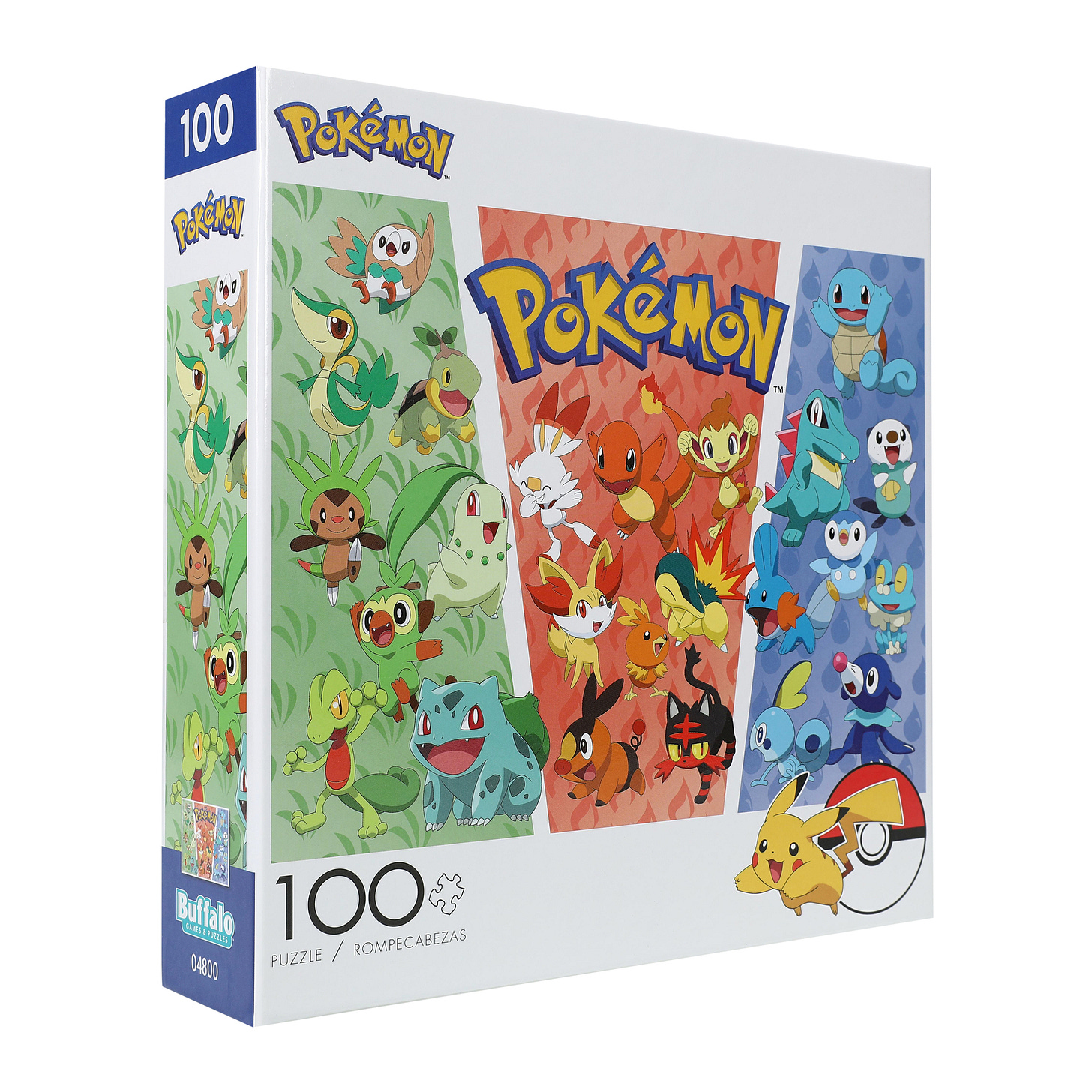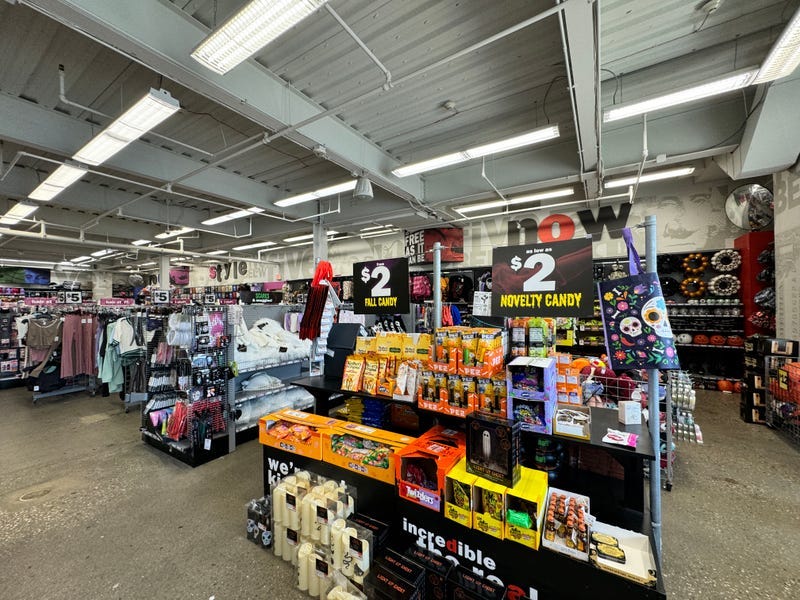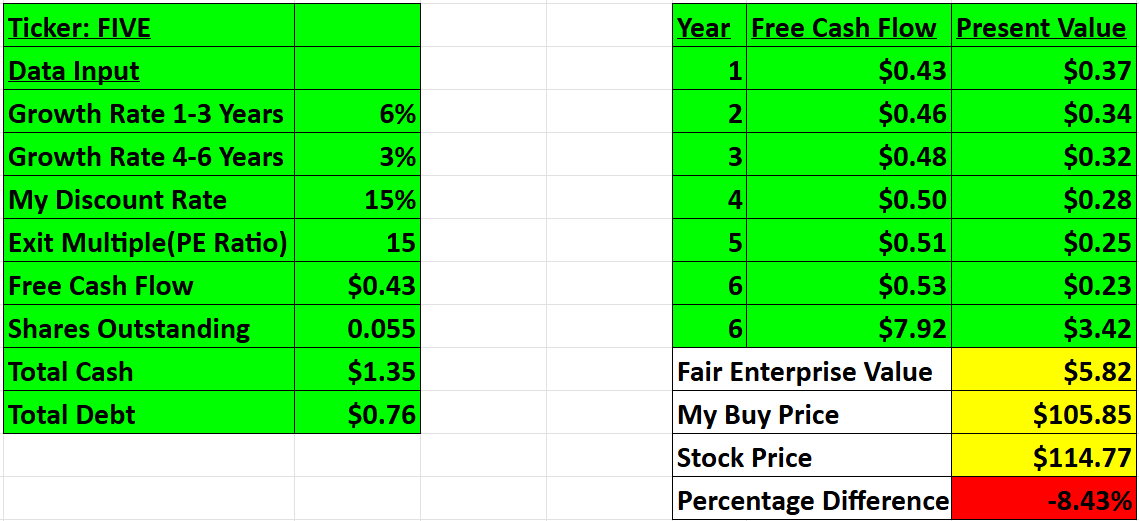Disclaimer: This newsletter is not financial advice; it is for educational purposes only. Please DO NOT take this newsletter as a buy or sell signal.
Five Below Fundamentals:
Below is a checklist I normally use when analysing a company’s fundamental health. If the company meets my criteria, it will be colour-coded in green, and if it fails to meet my criteria, it will be colour-coded in red, which means I need to investigate further and ask myself why this is the case.
As you can see below, there are 6 red boxes, and I am going to explain each one:
Current PE Ratio and Current Price To Free Cash Flow Ratio- Five Below currently has a PE Ratio of 23x and a Price To Free Cash Flow Ratio of 53x which might be an indicator that this company is currently trading at a premium to the market since the average stock market PE Ratio is 15x. One thing to remember is that if a company can grow over 23% from now until judgment day and it can sustain that growth then the current valuation will look cheap. This goes for the opposite side of the spectrum where if a company was trading at 15x earnings and they are only growing 3% a year that might seem expensive because the company can’t justify its valuation. The reason why there is a big discrepancy between Five Below's PE Ratio and Price To Free Cash Flow Ratio is that Five Below tends to reinvest its cash flow(capex) at a high rate of return. When a company does this especially if they are a growing company I tend to value them by their Price To Operating Cash Flow and currently Five Below is trading at 15x its Price To Operating Cash Flow.
5-Year Average Profit Margin- When analysing a company, I look for a 5-year average profit margin of over 10%. However, as this company operates in the retail industry where margins tend to be low I won’t penalise the company for not meeting my criteria. For a retailer an average profit margin of 8% is considered good as it indicates that the company has a competitive advantage.
Current Debt-to-Equity Ratio Below 1.0- Five Below has a debt-to-equity ratio of 1.10 which is above my 1.0 threshold. When analysing a company with this level of debt it's important to understand the factors driving it. Although Five Below has no debt its debt-to-equity ratio is slightly higher because the company is in a growth phase. During this time Five Below chose to reinvest its profits back into the business instead of taking on debt. While this strategy keeps its debt levels low if the growth of equity does not match the reinvestment rate it can lead to a higher debt-to-equity ratio.
Free Cash Flow- Five Below's free cash flow has decreased over the last five years due to the company's strategic decision to invest more in capital expenditure to expand its business. With capital expenditures (capex) guidance of $210 million to $230 million in fiscal 2025 these investments are expected to drive future growth and profitability.
Free Cash Flow Yield- Free Cash Flow Yield provides investors with another way to assess the value of a company. Free cash flow yield provides a better measure of a company's performance than the PE ratio because earnings can be manipulated based on accounting rules. The most common way to calculate free cash flow yield is free cash flow divided by the company's market cap. Generally, the lower the ratio, the less attractive a company is as an investment because it means investors are putting money into the company but not receiving an excellent return in exchange. A high free cash flow yield result means a company is generating enough cash to satisfy its debt and other obligations including dividend payout. Five Below's free cash flow yield is 2% which is lower than my 7% threshold and lower than the risk-free rate which is currently at 4.4%. These numbers might be slightly skewed due to the nature of the business where Five Below tends to invest heavily in capital expenditures. If we were to look at Five Below's Operating Cash Flow yield it is currently at 6.8%.
Business Overview:
Founded in 2022 by Tom Vellios and David Schlessinger, Five Below is an American discount store that specialises in offering a wide variety of trendy products priced at $5 or less, along with a smaller selection of items priced up to $25. Five Below is popular among tweens, teens, and budget-conscious shoppers seeking fun and affordable items like toys, games, gadgets, fashion, and accessories.
Business Sements:
Leisure- Five Below offers a wide variety of leisure products including board games, puzzles, and outdoor play items. These products are designed to promote fun, creativity, and appeal to a younger audience by encouraging them to explore their interests. Additionally, this segment features craft and DIY supplies that allow customers to express their creativity through hands-on projects.
Fashion and Home - The fashion and home segment combines trendy apparel and accessories with home decor items that cater to a young and stylish audience. In terms of apparel, Five Below provides a selection of clothing that reflects current trends such as graphic tees and comfortable hoodies. Accessories include jewellery and stylish sunglasses allowing customers to express their personal style without overspending. The home décor aspect features items such as wall art, decorative cushions, and bedding options. This combination encourages customers to personalise their spaces while staying on budget.
Snacks and Seasonal- Five Below's snack offerings play an important role in its product range. The snack and seasonal segment features trendy and fun items including a variety of candies and novelty sweets that attract a younger audience. The seasonal range is crucial for keeping the product range fresh and exciting throughout the year by offering holiday-specific decorations such as costumes and ornaments for major celebrations like Halloween, Christmas, and Easter.
Management:
When evaluating management, I judge the CEO based on several factors such as experience, capital allocation skills, and Incentives. In this section, I will discuss whether management incentives are aligned with shareholders.
Experience- Winnie Park has been the CEO and Director of Five Below since December 2024. Prior to this role she served as the CEO of Forever 21 starting in January 2022 where she led a brand refresh aimed at younger consumers and enhanced the company's omnichannel and social commerce strategies. Before her time at Forever 21 Winnie was the CEO of Paper Source from 2015 where she transformed the company into an omnichannel lifestyle brand and expanded its digital presence. Winnie has also held significant positions at DFS where she launched the global e-commerce site, and at Levi Strauss & Co., where she served as the Senior Director of Women's Merchandising. Additionally, she is an Independent Director at Sound Point Acquisition Corp and was previously a board member at Dollar Tree until December 2024 and at Express Inc. until January 2022. Winnie holds an MBA from Northwestern University's Kellogg School of Management and a Bachelor of Arts degree from Princeton University.
Below is an image illustrating the current experience of Five Below board members:
Capital Allocation- Capital allocation is very important when judging management because I want them to create value for shareholders, not destroy it. So far, Five Below has done a great job with capital allocation, as they are providing value back to shareholders by reinvesting into the business to further expand their operations.
Five Below DOES NOT pay a dividend. All their cash flow is being reinvested into the business for future growth.
Incentive- This is important because if the current board is buying shares of their own business it indicates that management believes the stock is undervalued and is confident in the company’s long-term prospects.
As you can see below, we have zero buy and one sell orders. Ronald Masciantonio(secretary) is the only insider selling Five Below shares, but I am not going to put too much weight into this because there are many reasons why someone might sell their stock.
Bull And Bear Case:
Bull Case
Bull Case- The first bull case is a long runway for growth. Five Below has a store expansion plan that aims to grow its footprint in both existing and new markets. This enables the company to capture more market share and increase brand awareness. The goal for Five Below is to have over 3,500 stores by 2030 which will double the current number.
Bull Case- The second bull case is their unique competitive advantage. Five Below focuses on attracting tweens and teens by providing trendy merchandise at various price points. This strategy is aimed not only at young shoppers but also at their parents and others who might be shopping for them. The company's merchandising approach combined with a vibrant store atmosphere creates an engaging retail experience that increases foot traffic to both physical stores and their website and encourages repeat visits.
Bull Case- The third bull case is adaptability to market trends. Five Below has demonstrated its ability to adapt to changing consumer preferences by quickly introducing trendy and themed products. This flexibility helps them maintain relevance and attractiveness in a competitive retail environment.
Bear Case
Bear Case- The first bear case is competition. The retail landscape is highly competitive with traditional discount retailers such as dollar stores and e-commerce platforms competing for the same customer base.
Bear Case- The second bear case is dependence on trends. Five Below's success heavily relies on trends, particularly among teenagers and young adults. If the company does not adapt to evolving consumer preferences it could experience declining sales.
Bear Case- The third bear case is limited market presence. While Five Below has been expanding its footprint, its current market presence may still be limited compared to larger competitors. If expansion efforts falter or if new stores do not generate sales, the company's growth targets may not be met.
Valuation:
In this section, I will discuss valuation. Using some basic metrics, I will compare Five Below to its industry rivals and determine whether the company is cheap relative to its peers. Then, I will value Five Below using a discounted cash flow model to determine a price I am willing to pay based on its expected growth rate and my desired return of 15%.
As shown below, when compared to its peers, Five Below scores 1/6, while Dollar Tree scores 4/6 and Dollar General scores 3/6. Five Below, Dollar Tree, and Dollar General each offer unique values and business models, catering to the different needs and preferences of shoppers. Below, I am going to compare each company:
Business Model -Five Below is primarily a discount retailer that targets tweens and teens by offering products priced at $5 or less. Their business model focuses on providing trendy, fun, and innovative items that appeal specifically to younger customers. By leveraging social media and pop culture trends, Five Below keeps its inventory fresh and relevant.
Dollar General's business model emphasises convenience and accessibility. The company operates a large number of small-format stores primarily located in rural and suburban areas where shoppers may have limited access to larger retailers. Dollar General offers a wide range of everyday necessities including food, household items, and personal care products often at a lower price. Their strategy focuses on maintaining high inventory turnover and operational efficiency to keep costs down.
Similar to Dollar General, Dollar Tree provides a wide variety of products but maintains a fixed price of $1.25 (up from $1.00). The company’s business model focuses on delivering value through low-cost items including household goods, party supplies, and seasonal merchandise. Dollar Tree operates both standalone stores and an increasing number of "Combo" stores which feature products from both Dollar Tree and Family Dollar another chain that it owns.
Market Reach- Five Below targets a younger demographic with its niche market focus. The stores are mainly located in urban and suburban areas appealing to a youthful audience that is attracted to trendy items and experiences.
With over 18,000 locations across the United States, Dollar General has a broad market reach. Dollar General stores are often located in areas with limited access to supermarkets or large retailers making it a go-to option for everyday shopping needs, particularly in rural communities.
With approximately 15,000 locations in the U.S. and Canada. Dollar Tree’s stores are found in both urban and suburban areas catering to a wide demographic that values affordability across various product categories.
Product Offering- Five Below specialises in trendy, non-essential items such as toys, gadgets, clothing, beauty products, and room decor. Many of these products are aimed at youth culture and reflect popular themes from media and social platforms.
Dollar General offers a wide range of products including food, cleaning supplies, personal care items, and seasonal goods. The store focuses on practical and everyday essentials often featuring national brands alongside its private label products.
Dollar Tree provides a wide variety of products all at a set price point. Their selection includes food, cleaning supplies, party goods, seasonal items, and personal care products. This fixed pricing model simplifies the shopping experience and offers great value for those seeking budget-friendly options.
As you can see, based on my conservative assumption, Five Below is looking to grow 8% over the long run, so I went conservative and assumed a 6% growth in the first 1-3 years, then the growth will slow down to 3% 4-6 years out. In my assumption, I also went with an exit multiple of 15x earnings, which is below the historical average at which Five Below has traded. Based on my assumption, I have come to a buy price of $105.85 compared to the current stock price of $114.77, which means right now, Five Below is trading above its intrinsic value.
Thank you for reading my newsletter on Five Below. Disclaimer: This newsletter is not financial advice. This is for educational purposes only, so please DO NOT take this as a buy or sell signal.
Follow for more:
Please remember to subscribe, share, and comment below if you find this newsletter insightful. Your support helps me continue my work.











